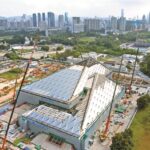On July 7th, in Baiyujing Town, Dingbian County, energy storage units branded with “Zhongyang Energy” were being loaded onto trucks. These devices will be transported to major oil fields in northern Shaanxi, providing “green power” to oil pumps deep in the mountains. Meanwhile, 300 kilometers away at the Qinchuangyuan Innovation Hub in Xixian New Area, engineers monitored real-time data on screens while fine-tuning the intelligent EMS system for oil fields.
Thanks to Qinchuangyuan’s continuously improving service ecosystem, Zhongyang Energy (Shaanxi) Energy Storage Technology Co., Ltd.—a tech startup established just over a year ago—has achieved multiple breakthroughs in energy storage R&D and applications.
“Our ‘R&D in Xi’an + Production in Yulin’ model breaks geographical and resource barriers,” explained the founder of Zhongyang Energy. “This approach facilitates collaboration between research teams, tech firms, and supply chains while effectively reducing production costs.”
Founded in March 2024, Zhongyang Energy focuses on advancing energy storage technology.
Startups in this high-tech sector face significant recruitment challenges due to the industry’s technical demands and talent concentration in urban R&D hubs. For companies like Zhongyang Energy based in northern Shaanxi, this hurdle is particularly acute.
The “flywheel incubation” model provided a breakthrough solution.
In 2023, Yulin’s Science and Technology Bureau established a satellite innovation center in Fengdong New City, partnering with Qinchuangyuan to pioneer this hybrid R&D-production model.
This model leverages Xi’an’s academic resources to fuel innovation while providing Yulin-based tech firms with comprehensive support services through Qinchuangyuan’s platform. Zhongyang Energy now operates with a 30-person R&D team (over 50% of its workforce) at the innovation hub, with Yulin providing free office space to maximize research investment.
Specializing in “new energy + storage,” the company developed lithium iron phosphate battery PACK systems and modular storage containers. “While lithium iron phosphate technology is mature, true differentiation comes from market-specific system innovations,” noted a project lead.
Their multi-source EMS system for oil fields reduced electricity costs to under 0.8 RMB/kWh while increasing crude recovery rates by 2%. The company now holds multiple patents for scenario-specific EMS systems, with 13 additional projects underway across five categories.
“For oil field electrification, we aim to achieve both cost reduction and carbon-neutral operations,” the founder stated.
Support policies further accelerated growth. Qinchuangyuan facilitated financing consultations and development planning, while local governments provided substantial subsidies—including 1.5 million RMB from Dingbian County for outstanding projects.
Within a year, Zhongyang Energy launched a 5GWh production facility in Dingbian and initiated pilot projects with multiple petroleum companies. The Xi’an-Yulin model has now incubated 24 tech firms with 17 more in development, attracting 18 experts from top universities to Yulin’s talent pool in 2025 alone. High-tech projects from Shanghai and Xi’an are currently being onboarded.
Similar innovation strategies are unfolding across Shaanxi:
• Xianyang pioneered legislation to streamline lab-to-market technology transfers
• Baoji integrated industrial and innovation chains, earning triple “Top 100” rankings in advanced manufacturing and specialized tech
• Yangling established “enterprise-team-base” partnerships to accelerate agricultural tech commercialization
These “headquarters+base” and “R&D+manufacturing” models continue to drive technological innovation, fueling Shaanxi’s high-quality development.



